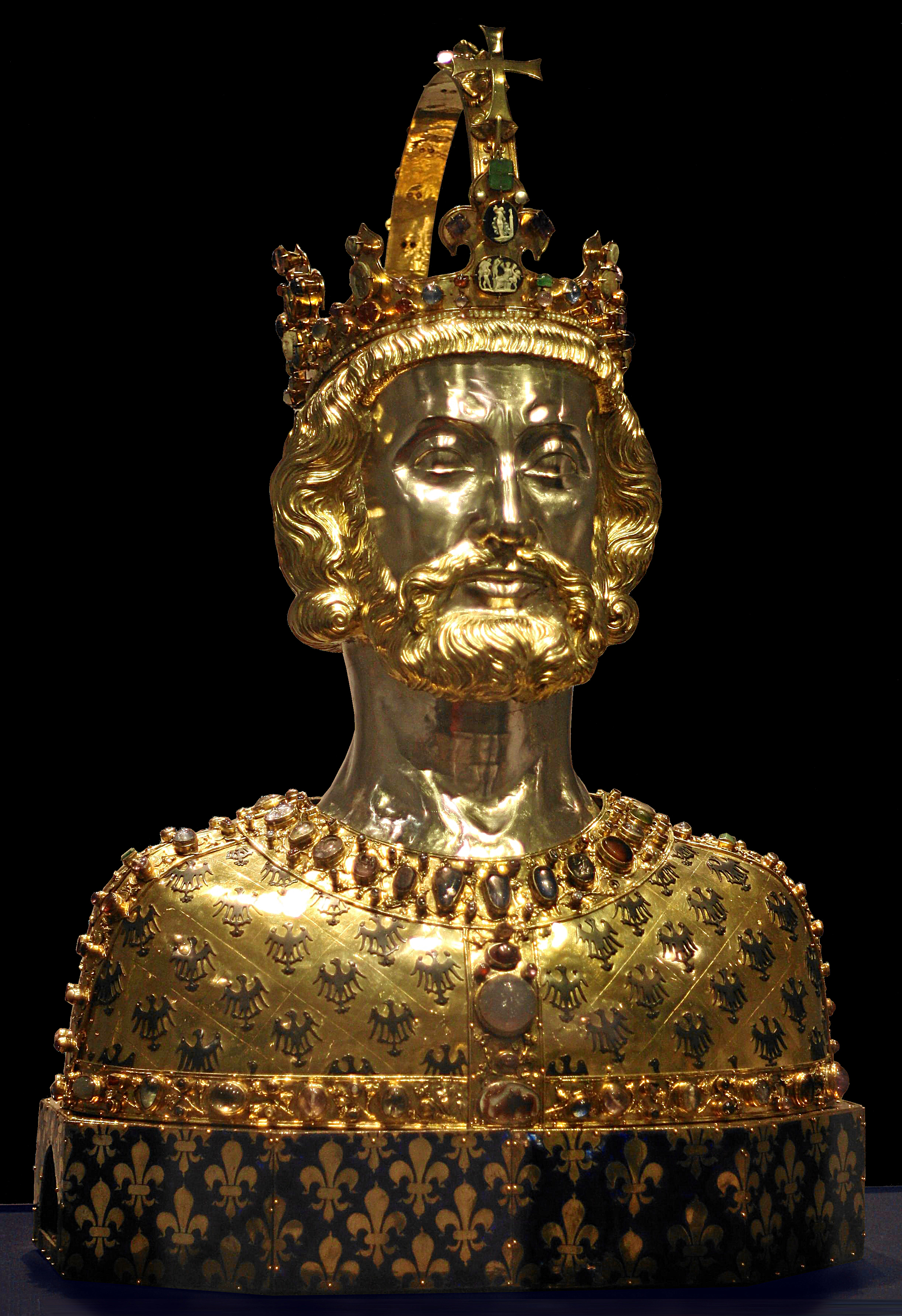 |
| Bust of Charlemagne in the Aachen cathedral treasury. Aachen, Germany (Wikimedia Commons) |
In ch. 35, Wilken treats Charlemagne, picking up the story of the Franks from ch. 27. He begins by listing Charlemagne as the fifth of the five great kings who shaped Christianity, after Caesar Augustus, Constantine, Theodosius, and Justinian.
On Charlemagne, The Rest Is History podcast has recently featured a a three-part series on the great king. I couldn't find the exact ones on YouTube, unless they're under different titles, but the three I'm thinking of are at Apple Podcasts here, here, and here. If you want video of Tom Holland and Dominic Sandbrook talking about Charlemagne, try the one below—it's the third in the series linked above. There's also this one, but the title doesn't correspond to any in the series linked above.
Einhard (c. 775–840, wikipedia) was a courtier of Charlemagne and wrote the authoritative biography (wikipedia). It's a brief work, only about 30 pages in the translation I'm looking at. Of course, it's available in all kinds of editions and translations; here's a recent(-ish) translation by Thomas Noble and published by Penn State. Or you can get an older one at the Medieval Sourcebook. There is a 1998 translation of Einhard's complete works by Paul Dutton. That translation by Noble is based on the Latin text edited by Louis Halphen, which is at archive.org (though, apparently, an earlier edition; Noble dates the edition he used to 1938), and the other standard edition in the MGH series is here. The Latin is also at the Latin Library. Wikipedia informed me that there is both an Einhard Foundation and an Einhard Society, both housed in Seligenstadt (wikipedia), a city founded by Einhard.
Wilkin quickly goes through Charlemagne's ancestry: Charles Martel ("the hammer"; c. 688–741; wikipedia) was merely a "mayor of the palace," though he was also the great power among the Franks while Merovingian dynasty of kings limped along, and Charles Martel was also the victor at the Battle of Tours in 732. He is the eponymous ancestor of the Carolingian dynasty.
One of Charles Martel's sons was Pepin the Short (c. 714–768; wikipedia), who was anointed king by Pope Stephen. "The anointing of the king was consciously modeled on an ancient ritual practiced by the kings of Israel" (Wilken p. 335). Wilkin mentions both the Donation of Pepin the Short, 754 (wikipedia)—granting land to the papacy—and the Donation of Constantine (wikipedia), for which see the text in Latin and English along with Valla's investigation (here).
And then we have Charlemagne (748–814; wikipedia).
Charlemagne's conquest of Saxony, 772–804 (wikipedia). "By 784 Charlemagne's armies had reached the Elbe, and the Saxon leader, Widekund, submitted to baptism" (Wilken p. 336). Apparently this Widekund (there are various spellings of his name) has been regarded as blessed in the Roman Catholic Church (wikipedia).
Wilkin mentions an abbot at Fulda who said that Charlemagne converted the Saxons "partly by wars, partly by persuasion, partly even by gifts." This was Eigil (wikipedia) in his Life of Sturm (here; see the section labeled "200" in brackets [i.e., the page number]).
On the forced conversions, this 2016 article by Daniel König (pdf) interacts with the theory of Yitzhak Hen that Charlemagne adopted the idea from Islam; König is not convinced. At any rate, the idea of forcing people to convert seems to have been new. Alcuin of York, among others, was deeply uncomfortable with the practice, and Charlemagne later moderated it for other groups. Charlemagne issued a capitulary for the Saxons (wikipedia, translation; and here is the MGH edition from 1883).
This chapter also discusses the growing rift between east and west, particularly regarding icons (with Theodulf's refutation of the decisions at the Council of Nicaea 787) and the filioque (wikipedia).
In ways small and large the distinctive features of Western Christianity were becoming evident by the time of the Carolingians. Besides images and the filioque, one might mention Benedictine monasticism, Latin rather than the vernacular as the language of baptism and the Eucharist, unleavened bread in the Eucharist, private penance, celibacy of the clergy, a piety centered on the cross (as in the hymns of Fortunatus), the popel and the emperor as two seats of authority. (Wilken p. 339)
The last few pages of this chapter cover Charlemagne's building program at Aachen, his being crowned emperor in 800, and the Carolingian Renaissance.
 |
| Aachen Cathedral (Wikimedia Commons) |
No comments:
Post a Comment